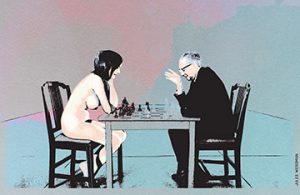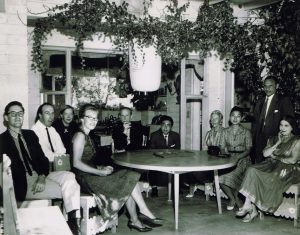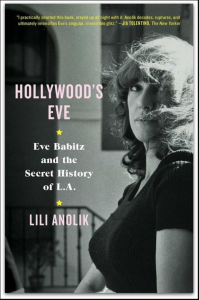FEATURES | By Mark Lewis
Eve’s Ojai
Literary Lioness & Her Ojai Connections

A Jules Weissman illustration of the famous Julian Wasser photo of Eve Babitz playing chess with Marcel Duchamp.
Rediscovered in her 70s, Eve Babitz now reigns as the new literary lioness of Los Angeles, celebrated for puncturing the quaint notion that Southern California is a cultural wasteland. But when Babitz lays out her anti-wasteland case, Exhibit A is not the L.A. Philharmonic or LACMA; it’s the Ojai Music Festival.
“There were Evenings on the Roof and the Ojai Festivals for concerts in our wasteland,” she wrote in her first book, “Eve’s Hollywood,” first published in 1974. “The Ojai Festivals were sponsored by the ladies of Ojai, a small community of old ladies who were seduced by John Bauer, an Englishman, who did a lot of things in Los Angeles by dint of sheer charm and energy …”
Actually, the charming Mr. Bauer was from New York. But his wife, Helen, was indeed English. They founded the Festival here in 1947 with help from friends, including Eve’s father, Sol Babitz, a violinist with the 20th Century Fox orchestra, and her mother, Mae, an artist. Eve (born 1943) and her younger sister, Mirandi, would be dragged up to Ojai every June to attend the performances. Eve liked Ojai but disliked the concerts. She may have been Igor Stravinsky’s goddaughter, but she was not into avant-garde classical music.
While she was still a teenager, Eve began cutting a wild-child swath through the L.A. of the ‘60s and ‘70s, dating the likes of Jim Morrison and Harrison Ford, creating arty album-cover collages for Buffalo Springfield and the Byrds, partying at the legendary Barney’s Beanery with bad-boy artists like Ed Ruscha. Her autobiographical books and essays are heavily laced with sex, drugs and rock ‘n’ roll. So why, when she came to write “Eve’s Hollywood,” did she make such a fuss about sleepy little Ojai and its annual classical music festival?
We tried to ask her, but Eve these days is very reclusive, and we could not snag an interview. Fortunately, we stumbled across a piece she wrote about the Festival for Westways magazine back in 1995. It was reprinted last fall in her latest book, “I Used To Be Charming,” a collection of her magazine pieces. You’ll find it reprinted (with permission) in this issue beginning on Page 81. But there’s more to the story of Eve and Ojai than she revealed to the readers of Westways. We poked around in her other books to dig up more clues.
Clue No. 1: The ruby-handled letter opener. Eve describes it in her Westways piece as a souvenir from China belonging to one Mrs. Grant, a kindly Ojai dowager who hosted the Babitz family in her stone house each year when they came up for the festival Mrs. Grant had kittens too, which Eve and her sister “considered just further evidence that the best place on earth was Ojai.” But in “Eve’s Hollywood,” she tells a slightly darker version:
“In her study was a knife brought back from the Orient by her brother in 1903 or something and it had a carved red ruby handle which I coveted each year until I stole it. I was so overwhelmed by what I had done that I buried the knife in our back yard when I got home and never looked at it again.”
Presumably, Mrs. Grant’s ruby-handled letter opener still lies buried in the former Babitz back yard on Cheremoya Avenue in Hollywood, waiting to puzzle some future archeologist who happens to dig it up.
Clue No. 2: “Marcel Duchamp and Eve Babitz,” Julian Wasser’s famous 1963 photograph of a nude Eve playing chess with a fully clothed Duchamp in a Pasadena museum gallery. She was 20; the Kennedy assassination was a month away; the ‘60s were about to kick into gear. The photo remains iconic, the go-to image people choose to illustrate the moment the L.A. art scene emerged from the wasteland and placed itself on the map. How did Eve come to pose for Wasser? The story begins several days earlier, when the Pasadena Art Museum (now the Norton Simon) held a private, invitation-only party at the Hotel Green to celebrate the opening of its now-legendary Duchamp retrospective exhibit.
“Guests included movie stars … and people played by movie stars (Beatrice Wood, the ceramicist and the real Catherine – the Jeanne Moreau role — in Truffaut’s “Jules and Jim),” Eve’s biographer Lili Anolik wrote.
Yes, Ojai’s own Beato, Duchamp’s former lover and lifelong friend, was at the Hotel Green that night, dominating the dance floor. She evidently felt a spark of nostalgic passion for her former flame, according to Kevin Wallace, director of the Beatrice Wood Center for the Arts. In his book about Beato’s friend Liam O’Gallagher (also present that night, chatting with Andy Warhol), Wallace writes: “When public accounts of Beatrice Wood doing the twist and exhausting a number of dance partners came out, she explained it differently. She admitted dancing with others as Marcel watched, but claimed that ‘… though his arms were not around me at the time, it was with him that I danced, as the music played on …’ ”
All in all, it was quite a night. All of Eve’s artist pals from Barney’s Beanery were there. Even Mirandi Babitz, Eve’s 17-year-old sister, was there, as Julian Wasser’s date. But Eve was not invited, even though it was her lover Walter Hopps who had organized the Duchamp exhibit. Hopps had left her off the guest list because his wife would be present. So, to get back at Hopps, Eve agreed to pose nude for Wasser.

Lili Anolik’s book on Eve Babitz
As it happens, Hopps was among the group of art luminaries whom Beato invited to Ojai to attend a luncheon she hosted for Duchamp a day or two after the Hotel Green party. A photo of this luncheon shows Beato gazing rather wolfishly across a table at the handsome young Hopps. Meanwhile, back in Pasadena, Wasser was arranging for the shoot, which took place at the museum several days later. Hopps was caught by surprise when he walked into the gallery to find a nude Eve sitting across a chessboard from Duchamp. Whether Eve’s stunt annoyed Hopps or impressed him is unclear, but it certainly captured his attention, and thus accomplished her purpose.
Years later, Eve apparently made a veiled allusion to Beato in an Esquire article she wrote about another former lover, Jim Morrison. By the time of her fling with Morrison, she had segued from Barney’s Beanery artists (Ojai-raised Ron Cooper was among her conquests) to Sunset Strip rockers. She thought Morrison was beautiful, but she was less impressed with his band.
“The Doors were embarrassing, like their name,” she wrote. “I dragged Jim into bed before they had decided on the name and tried to dissuade him; it was so corny naming yourself after something Aldous Huxley wrote. I mean, ‘The Doors of Perception’ … what an Ojai-geeky-too-L.A.-pottery-glazer kind of uncool idea.”
Geeky? Uncool? This comes across as a shot at Ojai’s best-known pottery glazer. But Mirandi Babitz Ssays Eve’s target probably was Ojai in general rather than Beato in particular.
“She was a big fan of Ojai when we were kids there but seemed to lose interest in it later and I think it was all too geeky for words around the time that she started writing,” Mirandi said via email. “I suspect her disdain for all things the Corey family loved may have had something to do with that because they moved to Ojai around 1965 or ’66. That was the great actor and acting coach Jeff Corey and his wife, Hope, who were long-term residents of Ojai from the mid-‘60s on. Eve hated all things Corey-related because we grew up across the street from them in the 1940s and ‘50s in Hollywood and she did not get along with the Corey children. But then she got back in love with the place when her friend Caroline Thompson, the movie writer, moved to a big farm outside of town.”
“Personally,” Mirandi added, “I loved Ojai from childhood on, loved the Coreys and stayed at their house to go to the Festivals, and remain a fan to this day. We all knew and loved the Bauers … John was a marvelous person, tall and handsome with an elegant back-east accent who was the inspiration for my own concert-promotion days, which I did for about 10 years. Mine were rock ‘n’ roll, but I learned so much from hanging around John. He was the bridge between the musicians and the Festival and accepted by them all because of the depth of his musical knowledge.”
Mirandi became friendly with Beato too in later years, and would visit her studio.
“My mother, the artist Mae Babitz, was a big fan of hers too. I took my mother to many Festivals in the later years of her life after my father died in 1982.”
So, at least 75 percent of the Babitz family — Mirandi and her late parents — remained steadfast fans of Ojai and its Music Festival. As for Eve, to judge from that piece she wrote for Westways, she eventually developed an appreciation for the Festival, despite her low tolerance for sitting through concerts.
And here’s another clue: the vignette she included in “Eve’s Hollywood” about visiting Ojai for the first time in many years, accompanied by her friend Tina.
“I hadn’t been to Ojai since I was about 9 and had been at the mercy of my parents who went and participated in the Ojai Music Festival each year,” Eve wrote. “I hoped it was still beautiful because it was a long drive and Tina was driving. But it was even more beautiful than I remembered and there was a lake now added and these gigantic haciendas that I hadn’t remembered for sale.”
The house she did remember was Mrs. Grant’s, where her family had stayed when she was a child. Later, after she and Tina had returned to L.A., they had a telephone conversation about their recent road trip:
“You know,” I said, it’s always been my secret ambition to get one of those stone houses up in Ojai.”
“Really?” She sounded a trace lightened. “God it’s beautiful up there.”
“Yeah, well, what I wanted to do was have this house and all these cats and orange trees and even a goat. A stone house with a dirt road.”
“Oh, that sounds fantastic,” she said. She could see it clear as day.
“And the thing was, my secret ambition has always been to be a spinster.”
“Yours too?”
“And then we’d have this house and every now and then we’d be visited by M. and other flashy people, but then they’d go away and we’d have this house and the sun would set and you’d be able to smell orange blossoms and we’ll never die.”
“Gee, that sounds terrific. Let’s do it.”
“OK,” I agreed.
So that’s what we’re going to do if we ever get out of Hollywood. And we both felt so much better, we met for a drink at Musso’s and ran into some friends.
 Eve Babitz never did get out of Hollywood. The years passed and her books went out of print and then in 1997 she suffered a traumatic injury when her dress caught fire. After that, she stopped writing and withdrew into seclusion. Then, around 2014, a new generation of readers discovered her work, and she came back into vogue with a vengeance. Nowadays, all her books are back in print and Hulu is making a TV series out of her “L.A. Woman.” So, if Eve still nurses the same secret ambition, she can now afford to buy that stone house in Ojai. Maybe Mrs. Grant’s old place is available.
Eve Babitz never did get out of Hollywood. The years passed and her books went out of print and then in 1997 she suffered a traumatic injury when her dress caught fire. After that, she stopped writing and withdrew into seclusion. Then, around 2014, a new generation of readers discovered her work, and she came back into vogue with a vengeance. Nowadays, all her books are back in print and Hulu is making a TV series out of her “L.A. Woman.” So, if Eve still nurses the same secret ambition, she can now afford to buy that stone house in Ojai. Maybe Mrs. Grant’s old place is available.


Leave A Comment